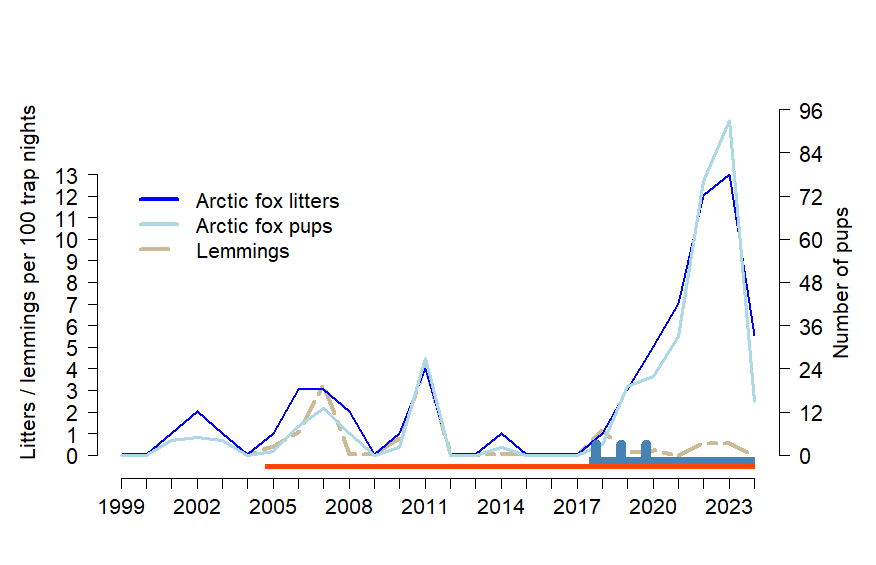Arctic foxes were abundant in Varanger and the rest of Finnmark (Norway’s northernmost county) until the beginning of the 20th century. However, thereafter the population sharply declined across the entire Fennoscandia, probably due to overharvesting. Despite strict protection since 1928 (Sweden), 1930 (Norway) and 1940 (Finland), the population did not manage to recover. However, almost nothing was known about the arctic fox in Finnmark at the onset of the project “Fjellrev i Finnmark” in 2004 – the precursor of the COAT Varanger Arctic fox module. It became evident that the species was extirpated from most of Finnmark and that only a few pairs were breeding in the interior of the Varanger Peninsula. On the other hand the red fox – a dominant competitor over the arctic fox – had become very abundant and widespread.
As part of the Norwegian Environment Agency’s fox conservation program red foxes have been culled on Varanger Peninsula from 2005, and the effect has been assessed within “Fjellrev i Finnmark”. Benefitting from lower red fox abundance and the lemming peaks in 2007 and 2011, arctic foxes reproduced successfully, and the population started to increase. Since 2011, however, there has not been any lemming peaks and only one arctic fox litter has been recorded. We have concluded that the red fox culling at the level carried out in Varanger was not sufficient alone to facilitate an increase in the arctic fox population in Varanger.

Den occupancy and the number of pups co-vary with the abundance of lemmings. The red line shows whven we started the red fox culling and the blue boxes shows the three yaers of breeded arctic fox releases in Varanger.
Expected climate impact
The impact of climate change on arctic foxes in Varanger, and in northern Fennoscandia in general, is indirect and likely to be mediated by several pathways.
The larger red fox is an important competitor able to exclude arctic foxes from the most productive denning areas and to monopolize carrion resources in winter. The considerable increase of the red fox population on Varanger observed during the last decades is part of a larger pattern of expansion of boreal generalist predators into the low Arctic. Climate warming and in particular the availability of resource subsidies are promoting this expansion. In Varanger, reindeer carrion is providing the critical subsidies for red foxes in low lemming years. Warmer winters with more rain lead to icing of pastures and may cause increased mortality of semi-domestic reindeer, and thus provide resources for expanding generalist predators.
Warmer winters and ground icing will also be detrimental for arctic foxes by their negative impact on lemming populations. Indeed, arctic foxes on Varanger depend on lemmings to reproduce, and are not able to raise pups successfully in vole peak years when lemmings are absent, such as in 2015.

Expected effects of climate change and management decisions on arctic fox in Varanger. Warmer winters have a negative impact on arctic fox through two potentially interacting paths: through the decreased availability of lemmings as prey, and through increasing abundance of generalist predators (red fox) which are benefitting from increased availability of ungulate carrion. Both ungulates and red foxes are subject to management actions.
Management relevance
Considerable efforts are made in Norway and the rest of Fennoscandia to secure the survival of local arctic foxes. In Varanger, COAT is assessing management options according to the principles of adaptive monitoring /management. The assessment of red fox culling as a stand-alone conservation action was done during 2005 to 2017. In the next phase (starting in 2018), supplemental feeding and release of captive bred arctic foxes together with maintained red fox culling will be implemented in close collaboration with NINA. Knowledge obtained from the arctic fox module is thus directly relevant for the conservation of this endangered species and for better prognosis concerning the future of arctic foxes in changing Fennoscandian ecosystems.
The camera-based monitoring of arctic foxes provide also data on area occupancy of red fox. Moreover, the large samples of culled red foxes provide a rich source of information of red fox genetics, demography and resource use. This allows for investigations that provide an understanding of what supports the expansion of this generalist predators and how the culling affects the population. This knowledge will be used to improve red fox management also in context of other conservation programs in Fennoscandia (Lesser white-fronted goose project).
Monitoring methods
The breeding population of arctic foxes is monitored through den surveys as part of the national monitoring program for arctic fox operated by NINA, according to provided instructions. Known dens are visited every year and inspected for fox activity and DNA for identification of individuals are collected. Automatic cameras are used to survey the dens, monitor arctic fox activity, determine the number of pups (if the foxes are breeding) and register disturbance by other species (in particular red fox, but also eagles and wolverine).
Late winter is a period of scarcity for tundra predators, where carrion can be an important resource. We use automatic cameras with baits to monitor the scavenger community, including arctic foxes and generalist predators such as red foxes and corvids, in March and April. Methods to estimate the numbers of generalist predators in summer are under development in the ptarmigan module.
Red fox population structure (demographics and genetics) and diet is monitored by collecting data from the carcasses of culled foxes.
Related projects
The arctic fox module on Varanger is part of the project Felles fjellrev - Together for the Arctic fox financed by interreg Aurora. In this project public authorities, researchers, and NGOs join forces to strengthen arctic fox populations shared by Norway, Sweden and Finland. The project is lead by Länstyrrelsen i Norrbotn and will focus on conservation measures for the arctic fox, but also on outreach activities to create awareness, involve more interest groups, and improve information availability.
